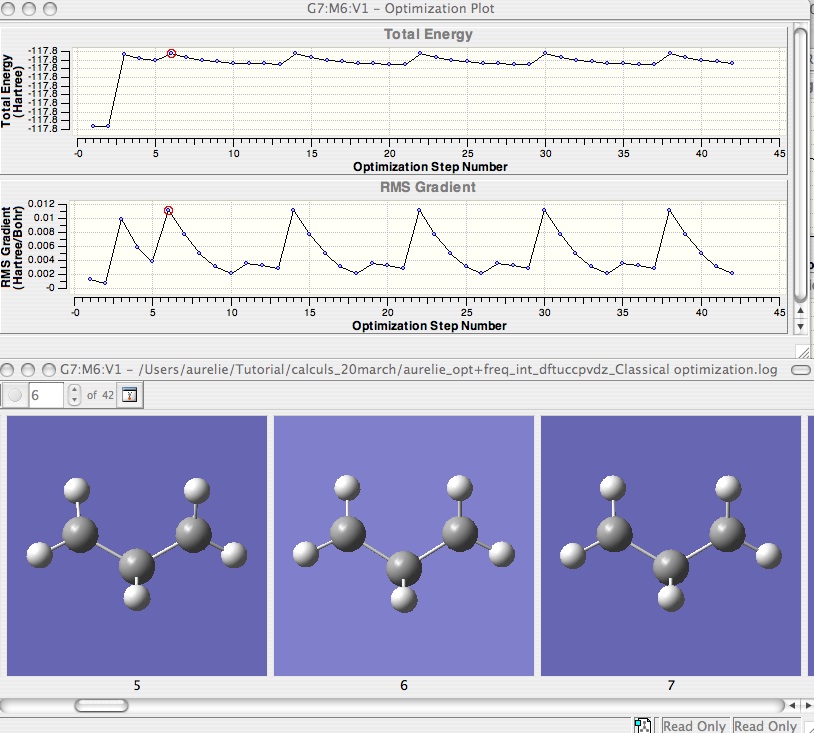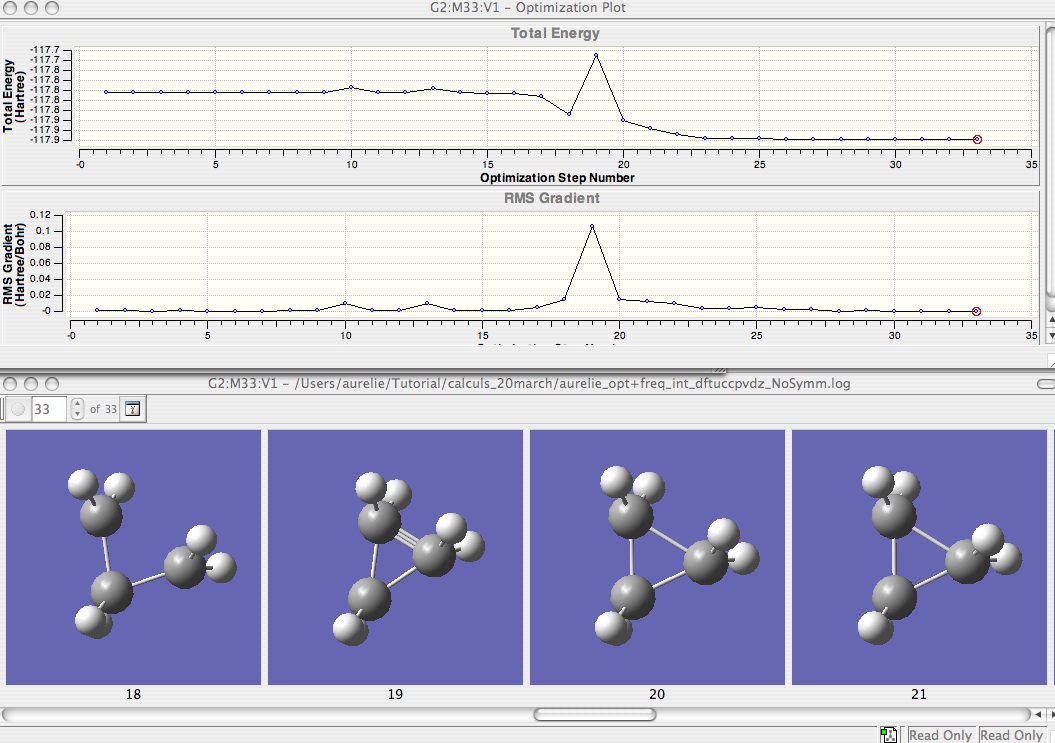The optimizations that I tried !
Normally you would have to look at this part, because this optimization is not very easy to obtain. In fact, the TS1 and INT are very close in energy (TS1 = 53.87, INT = 53.92), so it is a flat area around our intermediate.
Just below you will find all the keywords that I tried to optimize.
Classical optimization
First begin with some logical keywords : ask for reading the geometry of the checkpoint file of the previous frequencies calculation, reading the orbitals and try to optimize by reading the force.
#p opt=readfc guess=read freq geom=check ub3lyp/cc-pvdz
But the optimization does not succeed :
Item Value Threshold Converged?
Maximum Force 0.002712 0.000450 NO
RMS Force 0.001230 0.000300 NO
Maximum Displacement 0.106026 0.001800 NO
RMS Displacement 0.039167 0.001200 NO
Predicted change in Energy=-3.407889D-02
Optimization stopped.
-- Number of steps exceeded, NStep= 42
-- Flag reset to prevent archiving.
----------------------------
! Non-Optimized Parameters !
! (Angstroms and Degrees) !
-------------------------- --------------------------
If you export the file in your mac ( Copy a file from your account on the cluster to your mac ) and open it with Gaussview (File --- > Open , select your log file and ask for Read intermediate geometry). Thus you can look at the different steps of your geometry optimization. And normally you would be able to observe a reorientation of the molecule.

The reorientation of the molecule implies this sort of cycle which you can notice in the different graphs (for getting the graphs, do Results --- > Optimization ).
So, to prevent this we can add nosymm in our keywords.
NoSymm
#p opt=readfc guess=read freq geom=check ub3lyp/cc-pvdz nosymm
The optimization is successful, with this results concerning the frequencies :
1 2 3
A A A
Frequencies -- 729.0336 729.4974 852.7896
Red. masses -- 1.0230 1.0230 1.0444
Frc consts -- 0.3204 0.3208 0.4475
IR Inten -- 0.0000 0.0001 0.7136
Atom AN X Y Z X Y Z X Y Z
1 6 0.00 0.00 -0.03 0.00 0.00 0.00 0.00 0.00 0.03
2 6 0.00 0.00 0.02 0.00 0.00 0.03 -0.01 0.00 0.03
3 6 0.00 0.00 0.01 0.00 0.00 -0.03 0.00 0.00 0.03
4 1 -0.19 -0.27 0.18 0.38 -0.22 0.07 0.21 0.29 -0.19
5 1 0.13 0.30 0.18 -0.37 0.22 -0.08 -0.16 -0.32 -0.20
6 1 0.17 -0.39 -0.04 0.30 0.21 -0.13 0.38 -0.02 -0.14
7 1 -0.14 0.37 -0.15 -0.26 -0.24 -0.18 -0.32 -0.01 -0.25
8 1 0.42 0.04 -0.03 0.03 0.36 0.14 0.19 -0.33 -0.15
9 1 -0.40 -0.06 -0.14 -0.08 -0.34 0.18 -0.14 0.30 -0.24
And it is really a minimum because the forces converge :
Item Value Threshold Converged? Maximum Force 0.000167 0.000450 YES RMS Force 0.000048 0.000300 YES Maximum Displacement 0.001628 0.001800 YES RMS Displacement 0.000653 0.001200 YES
So this is a minimum, but not the same minimum as in the article, so we have to try again!
In fact, the minimum that we found is the cyclopropane ! You can notice it by exporting the file in your mac and open with GaussView in order to read the intermediate geometries.

Maxstep
The minimum that we found was not the right one, so in order to find the right one, we can try to minimize the area where can access the molecule during the optimization by putting MaxStep ( About MaxStep ) in our keywords.
#p opt=(rcfc,maxstep=5) guess=read freq geom=check ub3lyp/cc-pvdz
But the optimization is not successful...
Optimization stopped.
-- Number of steps exceeded, NStep= 42
-- Flag reset to prevent archiving.
----------------------------
! Non-Optimized Parameters !
If you have a look at the file, you can notice that in the beginning The energy and the S**2 were the correct one (like in the end of our guess=read freq calculation).
SCF Done: E(UB+HF-LYP) = -117.803131867 A.U. after 1 cycles
Convg = 0.5478D-08 -V/T = 2.0085
S**2 = 0.9835
But at the end the S**2 became 0, so we lost the information concerning our unrestricted calculation.
SCF Done: E(UB+HF-LYP) = -117.866256951 A.U. after 12 cycles
Convg = 0.9262D-08 -V/T = 2.0082
S**2 = 0.0000
Calcall
Then I tried with Calcall keyword (so I just ask instead of reading the force of calculating the forces step by step).
#p opt=(calcall,maxstep=5) guess=read freq geom=check ub3lyp/cc-pvdz
And after the successful optimization, the forces converged which is a good thing :
Item Value Threshold Converged? Maximum Force 0.000001 0.000450 YES RMS Force 0.000000 0.000300 YES Maximum Displacement 0.000003 0.001800 YES RMS Displacement 0.000001 0.001200 YES
But the frequencies are not the right one...
1 2 3
A A A
Frequencies -- 728.3068 728.4500 852.9776
So the minimum found is not the right one (it is the cyclopropane again...), and after exporting the log file and reading by Gaussview, I saw a reorientation of the molecule and so decided to use NoSymm.
#p opt=(calcall,maxstep=5) guess=read freq geom=check ub3lyp/cc-pvdz nosymm
And it is converge !
1 2 3
A A A
Frequencies -- 729.2879 729.7209 853.0277
But not in the right point (always cyclopropane!)... Try again!
Smaller MaxStep
Then I tried to put a smaller maxstep and ask for reading the force.
#p opt=(maxstep=2,rcfc) guess=read freq geom=check ub3lyp/cc-pvdz nosymm
And at the end of the calculation there is a message error, and this optimization is not completed!
Optimization stopped.
-- Number of steps exceeded, NStep= 42
-- Flag reset to prevent archiving.
----------------------------
! Non-Optimized Parameters !
But then I exported the file (log) in my mac, I saw that :
the point number 6 might be my minimum, because it looks like the minimum obtained with the optimization concerning the energy and the gradient, and the step 5 is indicated in the log file with converge forces.
Item Value Threshold Converged? Maximum Force 0.000420 0.000450 YES RMS Force 0.000133 0.000300 YES Maximum Displacement 0.059089 0.001800 NO RMS Displacement 0.017340 0.001200 NO Predicted change in Energy=-3.341507D-05
So we can try to extract the geometry of this point, and run a frequencies calculation.
Extract a point
The first thing that I can try is to use the Step keyword ( About Step ) to ask directly for the frequencies of the run that I am interesting to.
#p guess=read freq geom=(check,step=6) ub3lyp/cc-pvdz nosymm
(verifier le coup du 6...5) avec les graphes que je doi coller)
But I got a message error :
Charge = 0 Multiplicity = 1 Requested step has not been saved. Available points: 40 39 38 37 36 35 34 33 32 31 Available points: 30 29 28 27 26 25 24 23 22 20 Available points: 21 18 19 17 16 14 15 12 13 11 Available points: 10 9 8 Error termination
So, in order to keep the point that interest me, I decided to use MaxCycle.
Maxcycle
I introduced Maxcycle keyword ( About MaxCycle ), and reproduce the previous optimization calculation. Thanks to this keyword I would be allowed to stop the optimization at the point 10, and so the geometry of my point would be saved.
#p opt=(maxstep=2,rcfc,maxcycle=10) guess=read freq geom=check ub3lyp/cc-pvdz nosymm
So I have really my 10 points and so I notice that the point 6 could be my minimum, so I have to save the geometry of the point, and then run an optimization from this point.
Final optimization
Then, I tried to optimize to my minimum from the geometry of the point that I found in my previous optimization (with maxcycle). In this aim, I get back the geometry from the log file, put in the input file with the keywords :
#p opt=(maxstep=2,calcall) guess=read freq ub3lyp/cc-pvdz nosymm
And at the end the forces converged :
Maximum Force 0.000363 0.000450 YES RMS Force 0.000118 0.000300 YES
And the frequencies are close to the one in the article :
1 2 3
A A A
Frequencies -- 34.1057 197.9645 373.3945
Red. masses -- 1.0211 1.1081 1.8214
Frc consts -- 0.0007 0.0256 0.1496
IR Inten -- 0.1173 9.2453 1.0512
Then I looked at the energy to compare with my TS1 and to compare with the article
Sum of electronic and zero-point Energies= -117.731365
Which corresponds to ECyclopropane - EINTermediate = -53.91252165 kcal/mol.
So it is very near to the results in the article.
Output fair
Classical Optimization Media:aurelie_opt+freq_int_dftuccpvdz_Classical optimization.log
NoSymm : Media:aurelie_opt+freq_int_dftuccpvdz_NoSymm.log
Maxstep : Media:aurelie_opt+freq_int_dftuccpvdz_Maxstep.log
Calcall : Media:aurelie_opt+freq_int_dftuccpvdz_Calcall1.log
Media:aurelie_opt+freq_int_dftuccpvdz_Calcall2_nosymm.log
Smaller MaxStep : Media:aurelie_opt+freq_int_dftuccpvdz_Smaller MaxStep.log
Extract a point : Media:aurelie_opt+freq_int_dftuccpvdz_Extract a point.log
MaxCycle : Media:aurelie_opt+freq_int_dftuccpvdz_Maxcycle.log
Final optimization : Media:aurelie_opt+freq_int_dftuccpvdz_intchksuccess.log
Next part : Output fair
Back to Get back the results found in an article
Back to Suggestion of a transition state between propene and cyclopropane


